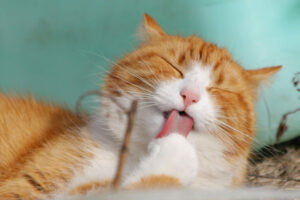Catnip, scientifically known as Nepeta cataria, has long been a subject of fascination. This unassuming perennial herb possesses a hidden secret, one that triggers a whirlwind of antics in our feline companions. But what exactly is catnip, and why does it have such a mesmerizing effect on cats? Join us on a journey to unravel the enigma of catnip and discover its intriguing world.
At the heart of the catnip mystery lies nepetalactone, a chemical compound related to mints. It is this elusive molecule that holds the key to why cats go wild in its presence. When catnip is crushed or bruised, it releases nepetalactone into the air, setting the stage for the captivating show that follows.
Nepetalactone has a peculiar effect on our feline friends. When exposed to it, cats exhibit erratic behavior – they rub themselves against it, play with it, and sometimes even indulge in a bit of nibbling. The exact mechanism behind this reaction remains shrouded in mystery, but some experts believe it might mimic certain feline pheromones, particularly the elusive facial pheromones. These pheromones, though not fully understood, are thought to be responsible for the quirky habit of cats rubbing their faces on various objects.
Cats’ response to nepetalactone is a fascinating rollercoaster ride. When initially exposed to the compound, they go into a frenzy, acting erratically and unpredictably. But here’s the twist – the effects wear off rather quickly, usually within an hour or two. However, as soon as they inhale catnip again, the whirlwind begins anew, and the cycle repeats itself.
Despite its seemingly narcotic-like effects, catnip is not considered toxic to cats, nor does it possess addictive properties. It’s more akin to how dogs react to specific scents; researchers suggest that nepetalactone stimulates a particular part of a cat’s brain, driving them to engage with the aroma. However, it’s crucial to note that cats can overindulge in catnip, which can lead to gastrointestinal issues like vomiting and diarrhea. Picture a cat getting lost in a giant bag of catnip – it’s a comical sight, but it’s essential to ensure their safety.
Here’s a quirk that adds to the catnip mystery – not all cats respond to it in the same way. Surprisingly, only about 70% of cats exhibit a noticeable change in behavior when exposed to catnip. What’s even more intriguing is that this responsiveness is genetically inherited. Some kittens may even have an aversion to catnip initially and might not develop an interest until they’re a few weeks old. It’s as if catnip holds a secret code that only certain felines can decipher.
Catnip’s Secret Life
Catnip’s intriguing properties don’t end with its effect on cats. This unassuming herb has the power to repel more than just our feline companions. In fact, nepetalactone extract from catnip is ten times more effective at keeping mosquitoes at bay compared to conventional mosquito repellents. While it works wonders when sprayed on clothing or surfaces, its efficacy dwindles when applied directly to human skin.
Beyond Catnip
While catnip steals the spotlight, it’s not the only natural mosquito repellent out there. Menthol, derived from mint, is another effective alternative. Mint leaves or oils rich in menthol can deter mosquitoes effectively. Some studies even suggest that mint oil may have lethal effects on the insects it repels, offering a more robust defense against mosquito-borne nuisances.
Mosquitoes have a knack for seeking out their human targets. Their attraction is primarily driven by carbon dioxide and octenol, substances found in human perspiration and breath. Mosquitoes can detect these chemicals from distances of up to 150 feet. Those who perspire more heavily or exhale greater amounts of these compounds tend to be more alluring to these pesky insects.
Understanding mosquitoes goes beyond their attraction to humans. These tiny insects have a fascinating life cycle. From eggs to larvae and pupae to adults, their journey unfolds in aquatic environments. Larvae feed on microscopic creatures like algae and frequently come to the surface for oxygen. Pupae, on the other hand, remain motionless at the water’s surface, undergoing a transformative process. Once they emerge as adult mosquitoes, they seek a dry spot to rest and dry off before taking flight.
A Powerful Mosquito Repellent
The battle against mosquitoes led to the development of DEET (N,N-Diethyl-meta-toluamide) by the United States Army in the 1940s. Initially used as a pesticide, DEET found a new purpose in protecting soldiers from insects. It became available for civilian use in 1957.
DEET’s effectiveness varies with concentration. A repellent with a 23.8% DEET concentration protects for approximately five hours, while a 100% DEET concentration extends the shield to about twelve hours. The active ingredient in DEET, octenol, disrupts mosquitoes’ sense of smell and vision, making it challenging for them to locate their human hosts. Recent studies even suggest that mosquitoes not only find DEET confusing but also strongly dislike its smell. Additionally, DEET affects the neurological systems and brains of insects, potentially leading to paralysis and, in severe cases, death from asphyxiation.
DEET’s remarkable properties extend beyond mosquito repellency. This potent chemical can serve as a nail polish remover and a solvent capable of dissolving some plastics, spandex, and leather. It’s a multifaceted substance that has found its way into various applications.
The Extraordinary World of Cats
Our exploration into catnip and mosquitoes has uncovered some remarkable facts. However, the world of cats is filled with even more astonishing tales. From calico cats’ unique genetics to the incredible number of kittens ever born to a single cat, the feline realm never ceases to amaze.
Intriguingly, there are around thirteen other compounds, apart from catnip’s nepetalactone, that can induce similar effects in cats. These compounds, such as onikulactone, boschnialactone, and actinidine, provide additional layers to the mystery of feline behavior. Each of these substances has its own story to tell when it comes to captivating our feline companions.
The allure of catnip remains an enigmatic puzzle, while our understanding of what captivates our feline companions grows. As we conclude, let’s embrace the enduring sense of wonder that cats and their behaviors continue to inspire, reminding us that the most intriguing mysteries often lie in the everyday experiences we share with our beloved pets.

How do you get your cat to utilize the litter box, or how do you…

A group of cats is accurately referred to as a clowder. Additionally, terms like ‘clutter’…

It’s common knowledge that cats are fiercely independent animals. We believe that this is a…

Tick and flea treatments are indispensable tools on the grocery list of what it means…

